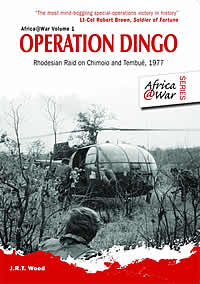Fireforce ‘Writ Large - Airborne Assault in Mozambique.
Startling in its innovation and daringly suicidal, Operation Dingo was not only the Fireforce concept writ large but the prototype for all the major Rhodesian airborne attacks on the external bases of Rhodesian African nationalist insurgents in the neighbouring territories of Mozambique and Zambia until such operations ceased in late 1979.
Fireforce as a military concept is a ‘vertical envelopment’ of the enemy (first practised by SAS paratroopers in Mozambique in 1973), with the 20mm cannon being the principle weapon of attack, mounted in an Alouette III K-Car (‘Killer car’), flown by the air force commander, with the army commander on board directing his ground troops deployed from G-Cars (Alouette III troop-carrying gunships and latterly Bell ‘Hueys’ in 1979) and parachuted from C-47 Dakotas.
In support would be a propeller-driven ground-attack aircraft and on call would be Canberra bombers, Hawker Hunter and Vampire jets. On 23 November 1977, the Rhodesian Air Force and 184 SAS and RLI paratroopers attacked 10,000 ZANLA cadres based at ‘New Farm’, Chimoio, 90 kilometres inside Mozambique. Two days later, the same force attacked 4,000 guerrillas at Tembué, another ZANLA base, over 200 kilometres inside Mozambique, north of Tete on the Zambezi River.
Estimates of ZANLA losses vary wildly; however, a figure exceeding 6,000 casualties is realistic. The Rhodesians suffered two dead, eight wounded and lost one aircraft. It would produce the biggest SAS-led external battle of the Rhodesian bush war.
§ Back to list |







